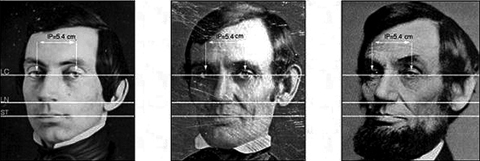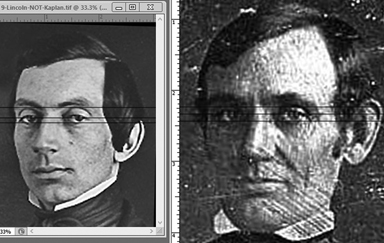LINCOLN PHOTO COMPARED TO A COLLECTOR'S PHOTO
by Joelle Steele
 The most important part of analyzing and comparing photos is simply looking carefully and observing the details, the similarities and the differences between faces. But when two faces appear very similar it is necessary to measure those facial details and see how they add up.
The most important part of analyzing and comparing photos is simply looking carefully and observing the details, the similarities and the differences between faces. But when two faces appear very similar it is necessary to measure those facial details and see how they add up.
Now, you might be thinking it's not possible to measure two faces and compare the measurements, and you are absolutely correct. You cannot measure features in one photo and then compare them to the other as did Claude N. Frechette, MD, a plastic and reconstructive surgeon who was hired in 1987 by a man named Albert Kaplan to analyze an old Daguerreotype that he believed was that of a young Lincoln. Below is Frechette's comparison of Kaplan's photo (far left), the Meserve #1 photo of Lincoln taken by Shepherd in 1846 (middle) and an 1862 Brady photo of Lincoln (far right).

The simplistic type of comparison above looks rather similar to what I do when I'm ruling out possible matches due to obvious misalignments between any two faces. But Frechette is actually measuring the distances between the pupils of the eyes and comparing them from photo to photo. This is definitely not what I do and it is not what you should do — not ever.
I have studied numerous Lincoln photos and Lincoln-wanna-be photos, so there is not an inch of Lincoln's face that I don't know inside and out. I have even measured and compared Lincoln photos to each other. So, I could see several very distinct differences between Lincoln and the man in the Kaplan photo. I knew, for sure, that they were not a match.
How did I know? Well, first of all, ears don't lie! They are the very first things I look at before I waste my time measuring anything else. Glad I did, because the ears don't match at all. Not only are the ears different in patterning, they are also slanted on the man in the Kaplan photo and much more vertical on Lincoln. But to try to prove to Kaplan and to others who were so sure it was Lincoln (don't know why since the ear difference is so obvious), I started from scratch.
From scratch for me normally means the ears. But if the ears aren't visible or someone still doubts that an ear mismatch is not enough to determine it's not the same person, then I go to the second step. That means aligning the pupils and sizing the irises. Why does this work? It works because once a person is fully grown, their eyeballs do not grow or shrink. So I align the pupils of each face so that they are level. Then I size the irises so that they are the same diameter on each face. This is extremely important because if you then compare the faces, everything should line up exactly if the two faces are the same person. If they don't line up, it is again a mismatch. Here's my comparison of Lincoln and the Kaplan photo with the eyes aligned and sized:

The man in the Kaplan photo is not even remotely a match for Lincoln. The eyes in the Kaplan photo are visibly larger in relationship to his face than are those of Lincoln, so that resulted in a 2.45% difference between the two faces. This means that the man in the Kaplan photo has eyes that are larger in proportion to his face than are those of Lincoln, and that Lincoln's head is therefore considerably larger than that of the Kaplan man.
Still need more proof? I chose a couple things to measure and compare after the pupils were aligned and the irises were sized. I selected the forehead, the nose, and the ramus — the most obvious non-matches aside from the ears. Here's what the measurements revealed:
FEATURE LINCOLN KAPLAN DIFF
Total Face Height 96 93
Forehead 36 37.5% 33 35.48% 2.02%
Nose 27.5 28.65% 29.5 31.72% 3.07%
Ramus 21.5 22.4% 16.5 17.74% 4.66%
The most obvious difference is in the overall height of the face, as measured from the most prominent hairline edge to the lowest edge of the mental protuberance. I had initially debated about using the hairline edge, but after studying several Lincoln photos, I noted that this part of his hairline did not change as he aged, so I felt it was a good measuring point. I used it for measuring the forehead along with the nasion or nasofrontal angle point (the top of the point in the skull where the suture between the two nasal bones meet). There was a 2.02% difference between the two faces.
But in measuring the nose from the nasion to the top of the nasal spine (columella-labial angle or junction), the difference in height for that feature grew to 3.07%.
The height of the ramus is something I always look for in comparing faces because it is a bone, and when it is visible, it can be an excellent indicator of a match — or not. Like ears, bones don't lie, and Lincoln's ramus was visibly higher than that of the man in the Kaplan photo. A 4.66% difference by measurement.
These percentages may seem small to you, but we're talking about a human face. Any difference over about a half-percent could easily make for a significant difference in appearance.
SUMMARY
Measuring is a great way to confirm a match or rule one out. In the case of the Kaplan photo, measuring wasn't necessary at all, since a quick visual comparison of the mouth, nose shape, eye size, and ears, reveal that they are not even close matches to those of Lincoln. But it pays to measure anyway, especially if identifying someone in a particular photo is very important to you. This happens so often to people who are writing their family histories and want to be sure that the person they think is Uncle Lloyd is not his older brother Irving who resembles him so closely. Since a photo is often said to be worth a thousand words, getting that identification confirmed by measuring is always your best and most reliable choice.

